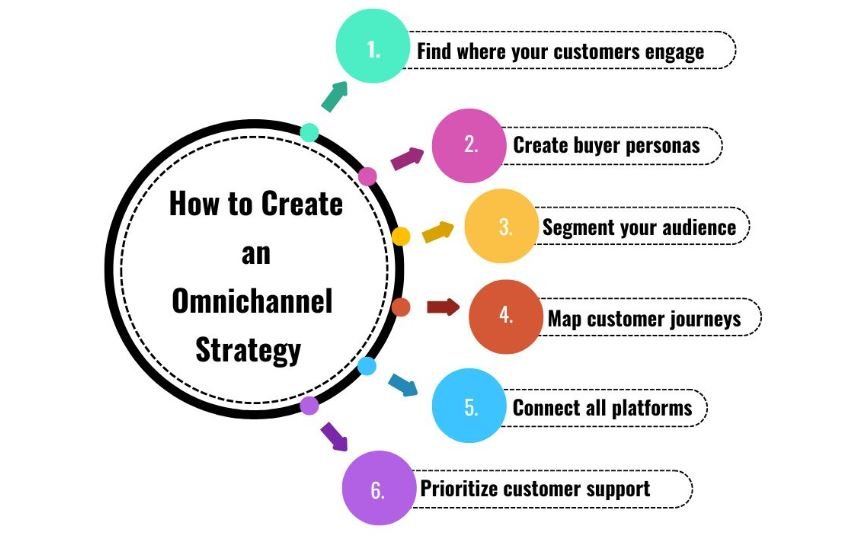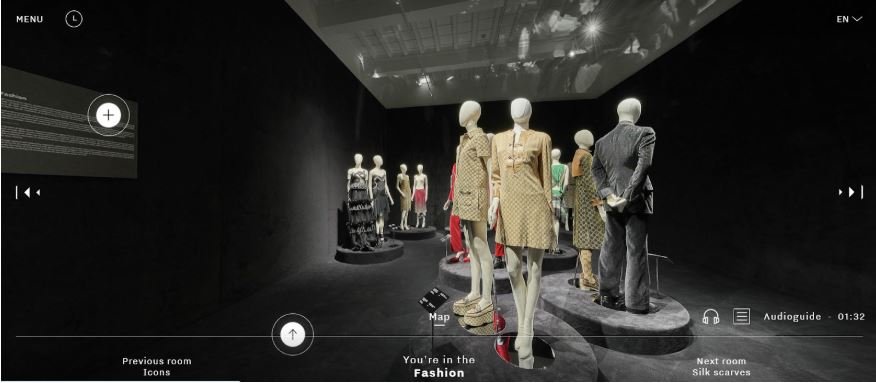What Is UI and UX ? And How They Benefit Businesses


Whether customers are browsing online, engaging with social media ads, or visiting a physical store, they expect a seamless shopping experience. Therefore, businesses need to break down silos between digital and in-store touchpoints to create a connected, data-driven omnichannel strategy.
However, achieving this level of integration requires more than just having multiple sales channels. It demands smart technology, personalized customer insights, and strategic execution to ensure a consistent brand experience at every step of the journey. A well-executed omnichannel strategy not only enhances customer satisfaction but also drives long-term loyalty and business growth.
In this article, we’ll discuss how to create a cohesive omnichannel strategy to offer unified customer journeys across all channels.
An omnichannel strategy connects all online and offline touchpoints. It ensures a consistent and personalized experience whether customers browse a website, scroll social media, or visit a store.
“Winning in an omnichannel world demands excelling in all channels, from in-person to hybrid, inside sales, digital self-serve, and marketplaces—especially during uncertain economic times in which a poor customer experience may lead to a lost sale.” Source

Today’s customers expect:
A survey by Salesforce states that 65% of customers stay loyal if a brand offers a more personalized experience. If your brand fails to deliver a connected experience, you risk losing customers to competitors who do.
Creating a seamless omnichannel experience needs a balance of strategy, technology, and customer focus. Some of the key elements include:
Ensure your brand’s messaging, visuals, and tone should be the same across all platforms, from website, social media, and in-store experiences.
Keep customers at the center. An omnichannel strategy aims to create meaningful connections with your customers. To do this, focus on their needs and preferences at every touchpoint. Use data to understand their behavior, identify areas for improvement, and enhance experience.
Omnichannel commerce enables seamless transactions across multiple channels, allowing customers to shop online. For example, searching for products, exploring a brand’s social media, and visiting websites to buy products. Omnichannel commerce ensures seamless and connected interactions, regardless of how customers engage with your brand.
Omnichannel marketing focuses on creating a consistent customer experience across all channels through messaging and branding.
Systems such as CRM, eCommerce platforms, and POS should be connected to track customer interactions across all touchpoints.
Here is a step-by-step guide to create an omnichannel strategy for your brand.

Identify the platforms that your customers use most to connect with your brand. Analyze their interactions and understand the preferences and problems they face. Next, determine how customer actions across multiple channels influence conversion.
By finding the most popular channels, you can refine your omnichannel approach to prioritize the ones that best align with customer behavior.
In order to attract new customers, brands need to convince prospects that they understand their needs and can solve their problems. Buyer personas help you connect with your target audience by personalizing marketing strategies that resonate with them.
Consider factors such as demographics, shopping behavior, buying preferences, communication channels and devices when creating buyer personas. Find out:
By creating detailed buyer personas, you can create personalized campaigns that show how you differentiate from your competitors and what value you provide.
Segment your customers to categorize them into groups based on common characteristics. This helps you to personalize interactions and implement targeted marketing. You can segment customers based on demographic, geographic, and psychographic factors. Further, you can personalize your messaging and offers for different segments. This helps you to identify at-risk customers and use behavior-based triggers to re-engage them before they leave.
Once you’ve identified your target audience, the next step involves creating personalized customer journeys based on their behaviors and preferences. Create detailed journey maps for all touchpoints, be it online or offline.
Customers don’t follow a single, predictable route. For a single campaign, they have their paths. Therefore, brands must connect these journeys seamlessly to improve engagement, ensuring a consistent experience no matter where or how a customer interacts.
Once you have a clear understanding of customers’ interactions across different platforms, you need to integrate these platforms into a unified omnichannel framework. Use insights from customer journey mapping to ensure smooth transitions between online and offline touchpoints.
For example, customers browse products online before visiting a store or use multiple channels before purchasing. Identify what drives these behaviors to create a consistent experience.
Customer support plays a critical role in an omnichannel strategy. Therefore, brands must meet each interaction with timely support to build trust and loyalty across all touchpoints. This strengthens your brand’s reputation and keeps customers engaged.
It is important to have the right technology to ensure a smooth customer journey across multiple touchpoints. From centralizing customer data to streamlining transactions, technology makes it easy to deliver a consistent and personalized omnichannel experience. Here’s how:
It is difficult to keep track of customers’ preferences and behaviors when they engage with your brand across different platforms. Siloed data leads to inconsistent experiences. Therefore, brands need customer data platforms (CDPs) and customer relationship management (CRM) software. These tools consolidate customer interactions from different touchpoints into a single source of truth, enabling marketing, sales, and support teams to personalize interactions.
Marketing automation helps brands to nurture leads and re-engage potential customers. For example, you can send reminder emails to customers who have added products to their carts but didn’t purchase them. Using automation helps brands to deliver promotional offers, send personalized recommendations, and optimize engagement.
Managing different sales channels can become overwhelming. However, brands can simplify their operations using connected commerce platforms. These platforms integrate inventory, order fulfillment, and payment systems into a unified dashboard.
Instead of manually tracking orders from different platforms, brands can use integrated systems that provide order visibility in real-time across all channels. In addition, connected commerce enables seamless payment experiences, allowing customers to choose their preferred method effortlessly.
Here are three ways using which brands can enhance their omnichannel strategy.
Integrate interactive technologies such as 3D product configurators and concierge services to connect online and in-store shopping. 3D product configurators let customers see products from all angles, customize color and material, and make informed purchase decisions. If you want to deliver a premium experience, consider offering at-home try-on services that allow shoppers to test products before buying to add a touch of exclusivity and stand out.
Brands need to do more than just sell products. They need to build meaningful connections with customers. Therefore, you should create a strong community and offer meaningful experiences to convert buyers into loyal brand advocates.
For example, Lululemon, a Canadian athletic apparel company, runs a Sweat Collective program to foster a fitness community through yoga classes, running clubs, and wellness events. This program aims to connect trainers, athletes, and fitness enthusiasts by offering them exclusive perks.
Brands can create digital storefronts in virtual worlds such as Roblox or Fortnite, where users can explore products in a 3D environment. This is especially useful for fashion, electronics, and luxury brands.
Gucci created a virtual experience called Gucci Garden, where users can explore virtual rooms inspired by real Gucci campaigns. They also sold limited-edition virtual items, some of which were resold for higher prices than real ones.

Let’s find out how brands such as L’Oréal and Puma use omnichannel personalization to offer seamless shopping experiences and strengthen customer relationships.
L’Oréal is a beauty leader globally. With a presence in 150 countries and 36 brands, the company reported €41.18 billion in sales in 2023. But, with such a vast reach, how does it deliver a personalized omnichannel experience for every customer at scale?
Since the brand spans across different continents, it faced challenges in complying with fiscal laws and retail practices. It also needed a strong omnichannel strategy to meet evolving consumer expectations.
“We have major compliance challenges because we operate in a wide range of countries. In addition, we have a real need for a strong omnichannel strategy, given the current context and the expectations of today’s consumers.” – Nicolas Koller, Global IT retail Manager for L’Oréal Group.
To address these challenges, L’Oréal partnered with Cegid Retail, a cloud-native POS and unified commerce platform. Cegid Retail gathers, stores, and manages data to seamlessly integrate compliance requirements. With support for 25+ languages, the platform helped the beauty giant streamline omnichannel operations and deliver an exceptional shopping experience to its customers, no matter how and where they shop.
“We have a major need for an omnichannel strategy that integrates CRM and e-commerce solutions. Optimising the customer experience is also one of our priorities”. Nicolas Koller
This way, L’Oréal serves its customers better, whether customers shop online, in-store, or through digital services.
PUMA, a popular sportswear brand offers an exceptional omnichannel retail experience to its customers. It uses SAP Emarsys’ customer engagement platform to deliver the right message to the right person at the right time. This ensures each interaction is relevant and timely, helping it to grab eCommerce opportunities.
With the help of an AI-powered personalization engine, the brand improves shopping experiences through product recommendations, personalized vouchers, and personalization based on loyalty and lifecycle stage. This strategic approach boosted engagement, driving a 5X increase in revenue from email marketing and a 50% growth in its customer database in just six months.
“By leveraging Al and automation against its rich vertical first- party data, SAP Emarsys allows brands like ours to generate greater insights into consumer behaviors, create more consistent, personalized journeys, and deliver them across all our consumers’ different touchpoints, whether online or offline, within one single platform. Our partnership has not only transformed how we communicate with our customers, but also allowed our marketing team to spend more time creating better engagement for consumers wherever and whenever they engage with our brand.” Rick Almedia, VP of eCommerce, PUMA
As customers move fluidly between online and offline shopping, brands that create a data-driven omnichannel strategy will thrive. By integrating insights from online interactions and in-store visits, brands can offer unified touchpoints and create a frictionless, personalized customer journey.
RBM Soft empowers businesses with cutting-edge eCommerce solutions tailored to enhance customer engagement and maximize conversions. With expertise in AI-driven personalization, seamless platform integrations, and emerging technologies such as AR and VR, RBMSoft helps brands create exceptional shopping experiences. Whether optimizing online storefronts, enabling multiple payment options, or leveraging advanced analytics, RBMSoft ensures your brand stays ahead of the curve.
Get in touch with us today to book a free consultation and learn more about how we can help.